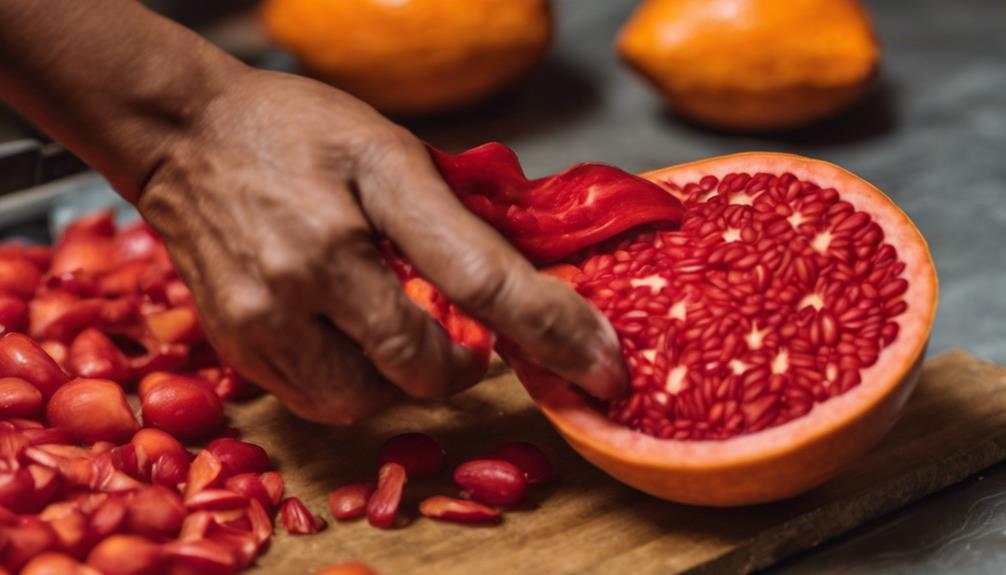When it comes to Colombian cuisine, the chontaduro is like a hidden gem awaiting your culinary exploration.
The vibrant tropical flavors and rich cultural heritage of this unique fruit come together to create a dish that will transport your taste buds to the heart of Colombia.
Discover the secrets behind preparing this traditional delicacy, and unlock the key to a truly authentic South American dining experience that will leave you craving for more.
History
When exploring the history of Chontaduro in Colombia, it reveals a rich cultural significance dating back centuries. The origins of Chontaduro can be traced to pre-Columbian times when indigenous communities revered this fruit for its symbolic importance in rituals and ceremonies. The fruit's deep connection to Colombian culture is evident in traditional dishes, folklore, and even art, showcasing its enduring cultural significance.
Chontaduro holds a special place in Colombian culinary traditions, with various preparations that highlight its versatility and unique flavor. From street vendors selling freshly boiled Chontaduros with salt to gourmet restaurants incorporating it into innovative dishes, the fruit remains a beloved ingredient across all strata of Colombian society. Its vibrant red-orange exterior and creamy texture add a burst of color and flavor to dishes, making it a staple in many Colombian recipes.
Beyond its cultural significance, Chontaduro offers a range of nutritional benefits, packed with essential vitamins, minerals, and antioxidants. Its role in Colombian cuisine goes beyond mere sustenance, embodying a cultural heritage that continues to thrive in modern-day Colombia.
Unique Flavor Profile
With its vibrant red-orange exterior and creamy texture, the Chontaduro fruit captivates taste buds with a unique flavor profile that has been cherished in Colombian culinary traditions for centuries.
- Flavor combinations: The Chontaduro offers a delicate balance of sweet and savory notes, making it a versatile ingredient in various dishes. Its subtle nutty undertones complement both spicy and tangy flavors, creating a harmonious blend that delights the palate.
- Cultural significance: In Colombia, the Chontaduro holds cultural significance as a symbol of fertility and prosperity. It's often featured in celebrations and traditional ceremonies, showcasing its importance in the country's heritage and culinary customs.
- Culinary uses: This fruit is commonly used in preparing refreshing juices, creamy desserts, and savory dishes like stews and sauces. Its rich texture adds a creamy element to recipes, enhancing both the taste and nutritional value.
Moreover, beyond its delicious taste, the Chontaduro offers health benefits such as being a good source of vitamins, antioxidants, and fiber, making it a valuable addition to a balanced diet.
Taste Sensation: Tangy and Sweet
Indulge your taste buds in the delightful tangy and sweet flavor sensation of the Chontaduro fruit, a culinary treasure deeply rooted in Colombian heritage and revered for its nutritional benefits. The Chontaduro offers a unique combination of flavors, blending a tangy undertone with a natural sweetness that's truly captivating. This flavor profile has made the Chontaduro a popular ingredient in traditional Colombian dishes, adding a wonderful balance to savory and sweet recipes alike.
In Colombian culinary practices, the Chontaduro is utilized in various ways to enhance the taste of dishes. Its tangy and sweet notes make it a versatile fruit that can be incorporated into both savory and sweet preparations. The fruit is often enjoyed on its own, boiled or roasted, and served with salt or honey, highlighting its contrasting flavors. Additionally, Chontaduro is frequently used in juices, jams, and desserts to infuse a burst of tanginess and sweetness into the final dish.
Recipe
Get ready to prepare a traditional Chontaduro recipe that has been passed down through generations.
Discover the cultural significance of this dish, as well as its historical roots in Colombian cuisine.
Uncover the nutritional benefits of the Chontaduro fruit and how it adds a unique touch to this beloved recipe.
Prep Time
When preparing the Chontaduro Colombia recipe, it's essential to consider the estimated time required for the preparation process. The prep time for this dish usually ranges from 20 to 30 minutes, depending on your familiarity with the ingredients and cooking techniques.
To enhance the flavors of the Chontaduro, you can experiment with different flavor combinations such as adding a hint of lime juice or a sprinkle of salt. For those looking to make ingredient substitutions, you can replace sugar with honey for a healthier alternative.
Additionally, garnish options like chopped cilantro or toasted coconut flakes can add a delightful touch to the final presentation of the dish.
Take your time to prepare the Chontaduro Colombia recipe thoughtfully to savor its rich cultural heritage and unique taste.
Nutritional Information
Curious about the nutritional content of the Chontaduro Colombia recipe? Chontaduros are not only a cultural delicacy in Colombia but also offer various health benefits. This fruit is rich in essential nutrients and can be a nutritious addition to your diet. Here's a quick look at the calorie content and health benefits of this traditional Colombian treat:
| Nutrient | Amount per Serving |
|---|---|
| Calories | 72 |
| Carbohydrates | 17g |
| Fiber | 2g |
Chontaduros are low in calories and a good source of fiber, which aids in digestion. Additionally, they are packed with essential vitamins and minerals, making them a healthy snack option. Incorporating chontaduros into your diet can provide you with a flavorful treat while supporting your overall well-being.
Ingredients
For crafting the Chontaduro Colombia recipe, gather the following authentic ingredients that capture the essence of Colombian cuisine:
- Chontaduros: These vibrant orange fruits offer a unique mix of flavors, combining sweet and savory notes. They're commonly used in Colombian cuisine for making juices, jams, and even traditional dishes like empanadas.
- Panela: A key ingredient in many Colombian recipes, panela is an unrefined whole cane sugar that adds a rich, caramel-like sweetness to dishes. It's often used in desserts and beverages, enhancing the overall flavor profile.
- Achiote: Known for its vibrant red color and earthy flavor, achiote is used to add depth to many Colombian dishes. It's commonly used in marinades, stews, and rice dishes, contributing both flavor and a pop of color to the cuisine.
Instructions
To craft the Chontaduro Colombia recipe authentically, it's essential to follow a set of traditional cooking instructions that highlight the rich culinary heritage of Colombian cuisine. Here are three crucial steps to guide you through preparing this cultural delicacy:
- Traditional Method: Begin by boiling the Chontaduros until they're tender, then peel off the skin and remove the seeds.
- Alternative Ingredients: Although traditionally served with salt and honey, some variations include serving them with cheese or condensed milk, adding a unique twist to the dish.
- Regional Variations: Different regions in Colombia might've their own unique way of preparing and presenting Chontaduros, showcasing the diverse culinary landscape of the country.
Serving Suggestion
For a traditional touch, consider serving the Chontaduro Colombia recipe alongside a garnish of fresh cilantro and a side of fried plantains. This presentation idea not only adds a burst of color to your dish but also complements the flavors of the chontaduro fruit.
The vibrant green of the cilantro contrasts beautifully with the rich orange hue of the chontaduro, creating an enticing visual appeal that's sure to impress your guests. Additionally, the sweetness of the fried plantains pairs perfectly with the slightly tangy and creamy texture of the chontaduro, offering a delightful balance of flavors.
This serving suggestion stays true to Colombian culinary traditions and enhances the overall dining experience.
Tips & Tricks
Enhance the flavors of the Chontaduro Colombia recipe by incorporating traditional Colombian spices and seasonings to elevate the dish's authenticity and cultural richness. Consider flavor combinations like cumin, achiote, and cilantro to add depth and complexity to the dish.
When cooking, try techniques such as slow simmering to allow the flavors to meld together beautifully. For ingredient substitutions, if chontaduro isn't available, you can replace it with ripe plantains for a similar texture.
Additionally, for presentation ideas, serve the dish in traditional Colombian pottery to showcase the country's vibrant culture. These tips and tricks not only enhance the taste but also offer a glimpse into the historical and cultural significance of Colombian cuisine, enriching your culinary experience.
Variations and Flavor Twists
Consider experimenting with different ingredients to infuse new flavors into your Chontaduro Colombia recipe. When exploring flavor combinations for your dish, you can try incorporating ingredients like lime juice for a tangy twist, coconut milk for a creamy texture, or a dash of cayenne pepper for a hint of heat. These culinary experiments can elevate the traditional Chontaduro recipe and offer a unique dining experience.
Historically, Colombian cuisine has been influenced by a blend of indigenous, Spanish, African, and Arab flavors, resulting in a diverse gastronomic landscape. By incorporating these varied influences into your Chontaduro recipe, you can create a fusion dish that pays homage to Colombia's rich culinary heritage.
Nutritionally, Chontaduros are rich in vitamins A and C, as well as essential minerals like potassium and magnesium. By adding complementary ingredients such as fresh herbs or nuts, you can enhance the nutritional profile of your dish while also adding depth to its flavor profile. Experimenting with different flavor twists not only adds excitement to your cooking but also allows you to tailor the dish to your personal preferences.
Final Thoughts
In concluding your exploration of the Chontaduro Colombia recipe, it's essential to appreciate the rich tapestry of flavors and nutritional benefits this traditional dish offers. The Chontaduro fruit has deep cultural significance in Colombia, often seen as a symbol of traditional Colombian cuisine and heritage. This dish not only provides a burst of unique flavors but also offers a range of health benefits due to its high content of vitamins A and C, as well as essential minerals like potassium.
When considering food pairings with Chontaduro, it's often enjoyed with salt, honey, or lime juice to enhance its natural sweetness and earthy undertones. Additionally, it can be accompanied by dishes like grilled meats, rice, or plantains to create a balanced and satisfying meal.
In essence, the Chontaduro Colombia recipe encapsulates the essence of Colombian culinary traditions, reflecting the country's biodiversity and cultural diversity. By savoring this dish, one can truly experience a taste of Colombia's vibrant culinary heritage.
Frequently Asked Questions
How Long Does It Take to Prepare and Cook Chontaduro in the Recipe Provided?
To prepare and cook chontaduro in the recipe provided, it takes about 30 minutes. The fruit's unique flavor profile blends sweet and nutty notes. Culinary uses include making chontaduro juice or serving it with salt.
Can Chontaduro Be Found in Other Countries Besides Colombia?
Yes, chontaduro can be found in countries beyond Colombia. Its global availability showcases culinary versatility. For instance, in Ecuador, chontaduro is enjoyed in various dishes, highlighting its presence beyond national borders.
Are There Any Health Benefits Associated With Consuming Chontaduro?
Eating chontaduro offers various health perks. Packed with nutrients like vitamins A and C, it boosts your immunity. Embrace its cultural significance while delighting in its unique taste. Expand your culinary horizons with this exotic fruit.
Is There a Specific Season When Chontaduro Is More Readily Available?
In Colombia, chontaduro shines brightest in the rainy season, offering its luscious fruits for all to enjoy. Cultivating these treasures requires patience and care, but the rewards are worth the effort.
Can Chontaduro Be Used in Both Sweet and Savory Dishes, or Is It Primarily Used in One Type of Cuisine?
Chontaduro's versatility shines in both sweet and savory dishes. Its unique flavor profiles make it a star ingredient in Colombian cuisine. Pair it with savory meats or blend it into sweet desserts for a taste adventure.
Conclusion
Indulge in the exotic flavors of chontaduro with this tantalizing recipe from Colombia. Let the tangy and sweet sensation transport you to the lush landscapes of South America.
With its rich history and unique flavor profile, chontaduro is a true culinary gem. So go ahead, savor every bite and experience a taste sensation like no other.
Embark on a gastronomic journey and discover the delicious world of chontaduro today.










